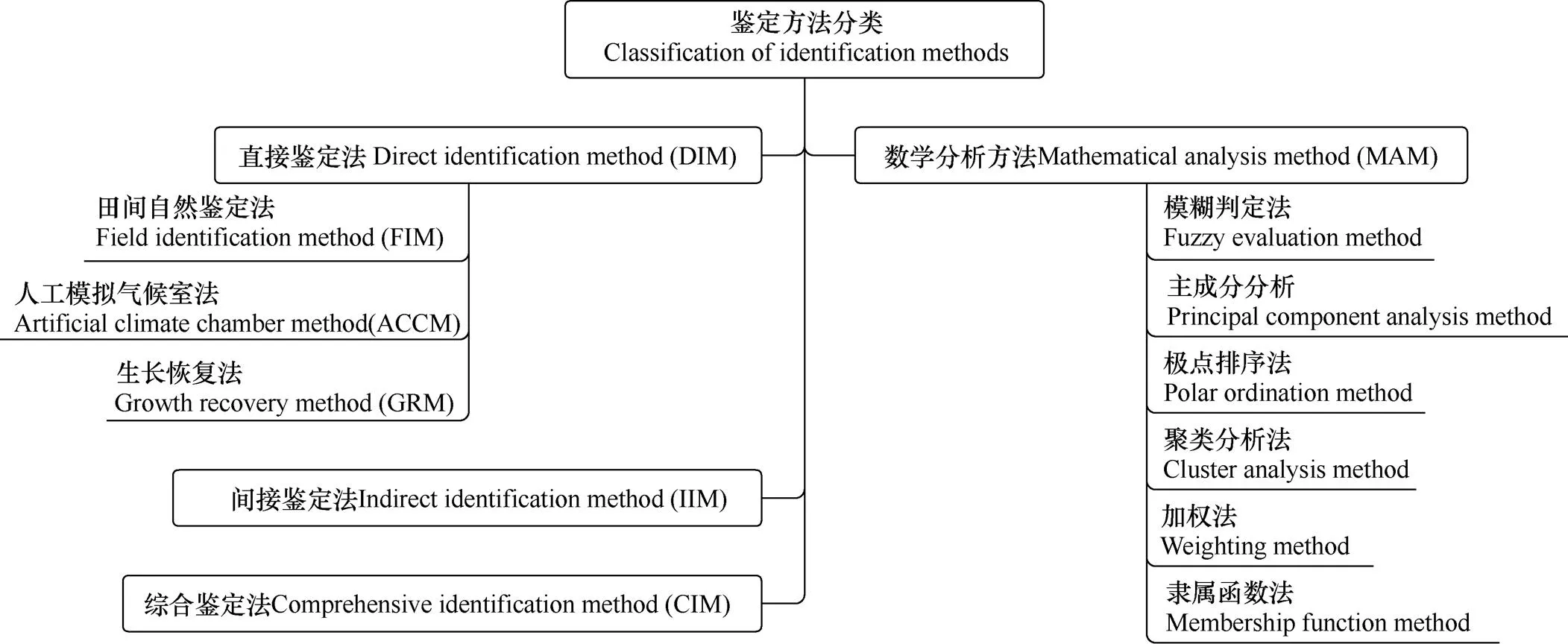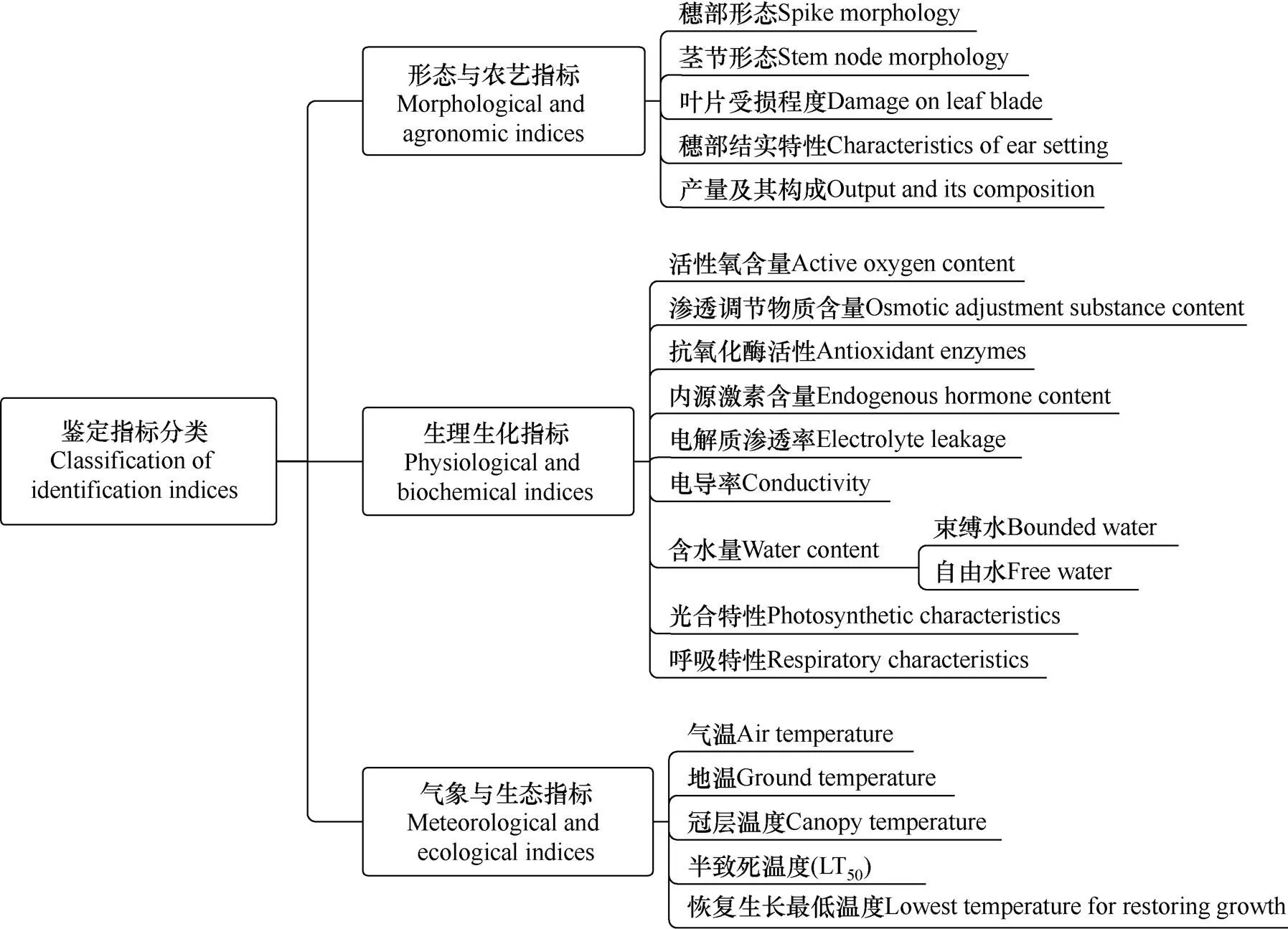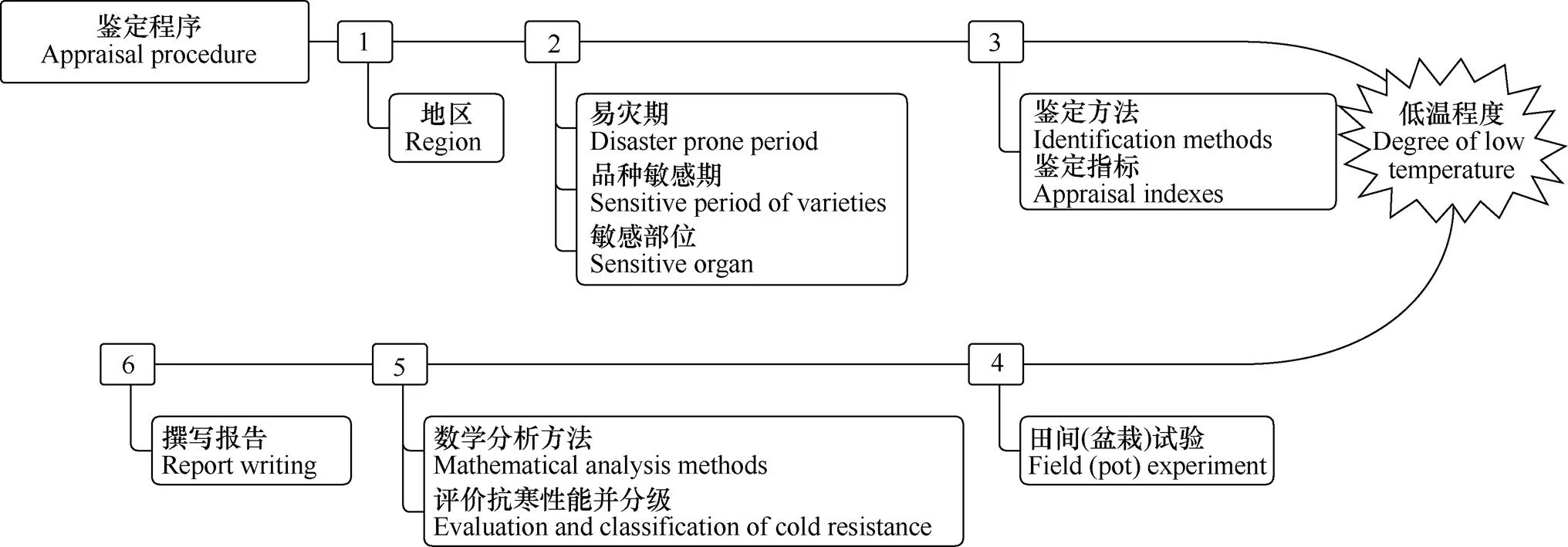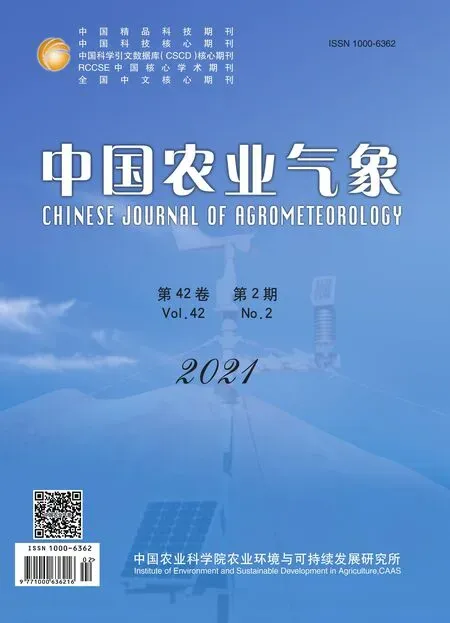冬小麦抗倒春寒性能鉴定方法和指标的比较*
张乐乐,陈 翔,柯媛媛,柳彬彬,Muhammad Ahmad Hassan,张 妍,许 辉,李金才,2**
冬小麦抗倒春寒性能鉴定方法和指标的比较*
张乐乐1,陈 翔1,柯媛媛1,柳彬彬1,Muhammad Ahmad Hassan1,张 妍1,许 辉1,李金才1,2**
(1.安徽农业大学农学院/农业农村部华东地区作物栽培科学观测站,合肥 230036;2.江苏省现代作物生产协同创新中心,南京 210095)
倒春寒是限制黄淮冬麦区小麦稳产和丰产的主要因素之一,选育抗倒春寒小麦新品种是降低倒春寒危害的重要手段,建立简单易行、易推广且全面系统的小麦抗倒春寒性能鉴定方法和指标体系对保障粮食安全有着重要意义。本文系统总结了冬小麦抗倒春寒鉴定的方法和指标,进行了比较和评价,并提出鉴定原则和程序。(1)鉴定方法方面,主要包括直接鉴定法、间接鉴定法和综合鉴定法等,直接鉴定法有田间自然鉴定法(引种栽培应用最广,但周期长、工作量大)、人工模拟气候室法(周期短、可重复性强,但对设备与技术要求较高)和生长恢复法(冬前冻害鉴定较多,抗倒春寒鉴定方面较少,一般与其它鉴定方法配合使用)等;间接鉴定法有助倒春寒危害温度阈值的研究,但目前指标与抗寒性关系还未有明确定论,应用受到限制;综合鉴定法鉴定结果全面而准确,但对技术、成本要求较高且工作量较大。因此,在鉴定过程中要结合实际情况合理搭配、综合运用。(2)鉴定指标方面,主要包括形态与农艺、生理生化、气象与生态指标等,形态与农艺指标一般用于田间自然鉴定法,常以数量、质量、颜色和形态变化等作为参考项;生理生化指标一般用于间接鉴定法,包括活性氧、渗透调节物质、内源激素含量、抗氧化酶活性以及光合与呼吸特性等;气象与生态指标常应用于各种鉴定方法,气温、地温、冠层温度、半致死温度和恢复生长最低温度常作为鉴定指标,而光照、CO2、湿度和肥力等因素会影响结果准确性。(3)关于鉴定原则与程序,本文提出了鉴定结果的地域性、指标选用的针对性、鉴定方法与指标的综合性和实用性等鉴定原则,并以易灾期、品种敏感期、敏感器官、鉴定方法和指标、低温程度、田间/盆栽试验、数学分析方法、抗寒性能评价与分级为主要流程的鉴定程序。最后,从抗寒生理研究、新兴技术鉴定研究与应用和鉴定产品的研发等方面做了展望。
冬小麦;倒春寒;鉴定;指标;方法
小麦(L)是世界三大粮食作物之一,全球约60%的人口以小麦为主食[1]。2050年世界人口预计达到97.3亿,小麦产量年均增长率要达到2.4%才能满足全球人口增长对粮食的需求,但目前全球小麦产量年均增长率仅为0.9%[2−3]。同时随着全球气候变暖,极端低温灾害事件频发重发,严重影响了小麦的稳产、丰产[4−5]。低温灾害给中国、美国、澳大利亚以及部分欧洲国家的小麦生产造成了极大的损失[6−11]。据报道,1995−2010年美国堪萨斯州的低温灾害事件发生次数多达41次,导致小麦减产超过538kg·hm−2[6]。澳大利亚昆士兰和新南威尔士北部每年因低温灾害导致小麦减产10%[7],年均经济损失达1亿澳元[8]。1980−2020年中国小麦主产区发生近20次大规模低温灾害事件,其中尤以黄淮冬麦区的倒春寒(Late Spring Coldness,LSC)危害最为严重,该地区发生频率可达40%,在2009、2013、2015、2018和2020年均有发生[9−11]。因此,倒春寒已成为限制中国小麦稳产丰产与优质的主要农业气象灾害。
小麦倒春寒灾害主要指在拔节−孕穗期遭遇突然降温天气,造成幼穗受伤或死亡,部分小穗不结实甚至全穗不结实,从而导致小麦减产的一种农业气象灾害[12]。前人从光合作用[13]、呼吸作用[14]、活性氧代谢[15]、渗透调节[16]、内源激素代谢[17]以及蛋白质组学[18]和基因标记技术[19]等方面对倒春寒危害机理[20]进行了大量研究,但其致灾机理尚未明确。同时由于倒春寒的发生具有随机性与不可预见性,且受害症状具有隐蔽性,从而导致灾前预防和灾后减灾措施难以及时到位,因此,小麦生产中应对倒春寒的防灾减灾能力不强。选用抗倒春寒品种是小麦生产中降低倒春寒危害的重要手段,但由于缺少准确有效的鉴定方法和指标体系以及相关标准,使得抗倒春寒品种的选育面临重大难题。因此,本研究通过总结和综合评价前人研究的冬小麦品种抗倒春寒性能(Tolerance against Late Spring Coldness,TLSC)鉴定方法和指标,提出相关鉴定原则和程序,并对未来的研究方向进行展望,旨在为抗倒春寒小麦新品种选育和减灾保产提供理论参考。
1 冬小麦品种TLSC鉴定方法
1.1 鉴定方法分类
目前,冬小麦TLSC鉴定可以参考小麦品种抗寒性鉴定的一般方法,主要有三种,分别是直接鉴定法(DIM)、间接鉴定法(IIM)和综合鉴定法(CIM),这些方法通常与各种数学分析方法(MAM)组合使用。各种方法的具体分类见图1。

图1 冬小麦品种TLSC鉴定方法分类
1.2 鉴定方法的优劣势分析
1.2.1 直接鉴定法
(1)田间自然鉴定法(FIM)
FIM是在倒春寒发生后对田间受害植株的器官或组织以一定的标准进行评价和比较,根据作物受灾表现评价其抗寒性的一种直观鉴定方法。该方法是引种栽培应用最广泛的一种鉴定方法,也是公认最早、最有效的鉴定方法之一[21]。农业农村部标准《NY/T 1307−2007》[22]中提出的小麦抗寒性分级就是利用这一方法将冬麦区春季阶段的小麦抗寒性分为5级,即1级(无冻害表征)、2级(叶尖受冻发黄)、3级(叶片冻死一半)、4级(叶片全枯)和5级(植株或大部分分蘖冻死)。乔玉强等[23]在倒春寒发生年份对同一品种进行不同播期试验,调查了田间异型穗率、残缺穗率和无籽穗率,结合其它相关指标通过聚类分析得出同一品种在不同播期和不同地区的TLSC强弱表现均有差异,表明田间栽培管理措施和不同地区易灾期以及冻(冷)害敏感期等因素影响着品种的TLSC评价结果。FIM虽然能较好地鉴定冬小麦TLSC,但由于鉴定周期漫长且工作量较大,一定程度上影响了抗倒春寒新品种选育和推广效率。
(2)人工模拟气候室法(ACCM)
ACCM是通过人工模拟大田低温环境来进行小麦抗寒性鉴定的一种常用方法。目前,利用该方法研究小麦抗寒生理机制和鉴定小麦抗寒性已成为主流。Liu等[24]利用ACCM在小麦拔节期和孕穗期进行低温胁迫模拟试验,发现低温胁迫程度和持续时间显著影响小麦的光合生产能力,进而影响产量的形成。Zhang等[25]利用ACCM发现孕穗期低温会诱导穗部脱落酸的积累,同时提升蔗糖合成酶的活性,进而增加穗部蔗糖含量来提升抗寒能力,但会影响幼穗的正常发育。ACCM鉴定周期较FIM短,可重复性强,同时减少了环境与品种基因型互作的影响[26]。但该方法对设备要求较高,且对各种变量也有严格要求,尤其是对温度参数的设置,需要对大量气象数据进行分析确定合理的降温模式和水平。
(3)生长恢复法(GRM)
GRM是通过观察和测定小麦植株或组织受低温胁迫后各项指标的恢复水平来评判其抗寒性的一种鉴定方法。半致死温度(LT50)是该方法中最常用到的指标,多用于小麦冬前冻害的鉴定[27−28],但单独利用GRM鉴定冬小麦品种TLSC的情况较少。GRM常与ACCM、IIM等鉴定方法配合使用,通过小麦各项指标的恢复水平对其TLSC进行鉴定。
1.2.2 间接鉴定法(IIM)
IIM是采用化学和生物技术研究作物群体、个体、组织器官与细胞的生理生态变化,通过分析各项指标与抗寒性之间的关系来鉴定小麦抗寒性的一种方法。倒春寒发生后,通过测定可溶性糖等渗透调节物质的含量、活性氧含量与抗氧化酶活性、含水量与电导率、光合特性、呼吸特性等相关指标[29−39],以及对小麦受冻细胞的显微与超微结构观察[40]等来鉴定小麦抗寒性的方法均属于IIM。该方法通过量化各项指标准确反映冬小麦的TLSC,有助于倒春寒危害的温度阈值研究。但由于机理复杂,目前部分测定指标与抗寒性关系还未有明确定论,该方法的应用受到限制。
1.2.3 综合鉴定法(CIM)
CIM是将多种鉴定方法与鉴定指标相结合,利用统计分析方法,综合鉴定或评价小麦抗寒性的一种方法。李桐等[41]利用了ACCM、FIM和IIM综合鉴定冬小麦品种,通过各种方法相互验证研究发现室内快速降温处理结合超氧化物歧化酶(SOD)活性及抗坏血酸、过氧化氢和丙二醛(MDA)含量的分析,能有效鉴定出小麦品种抗寒性的强弱。因此,利用ACCM结合GRM、FIM和IIM等多种方法和多种指标综合鉴定冬小麦TLSC,其鉴定结果可能更加全面而准确,但该方法对技术、成本要求较高且工作量较大。
1.2.4 数学分析方法
主成分分析法(Principal Component Analysis Method)[42]、聚类分析法(Cluster Analysis Method)[43]、极点排序法(Polar Ordination Method)、隶属函数法(Membership Function Method)[44−45]、加权法(Weighting Method)以及模糊评判法(Fuzzy Evaluation Method)[42]等是TLSC鉴定常用的数学分析方法。主成分分析法通过降维和去噪,加快对样本有价值信息的处理速度,常被用来筛选TLSC鉴定的关键性指标。马德栗等[46]利用主成分分析法对湖北省1951−2010年的倒春寒灾害事件建立了评估模型,并对其危害程度做了等级划分。隶属函数法、加权法和模糊评判法在小麦TLSC鉴定的使用过程中需设定各指标的权重值,相对于主成分分析法,其主观性较强。此外,鉴定中也常用到一些数学模型,例如累计低温度日(Accumulated Cooling Degree Days,ACDD,℃·d)也能作为数学分析方法较好地量化不同低温胁迫强度和持续时间的综合效应[1,47]。
2 冬小麦品种TLSC鉴定指标
2.1 鉴定指标分类
鉴定冬小麦品种的TLSC,不仅要选择合适的鉴定方法,还要选用合适的鉴定指标。小麦遭受倒春寒危害后,植株内部会发生一系列复杂的生理生化变化,外部形态也会表现出不同的受害特征,从而影响产量和品质。目前,国内外学者根据冬小麦植株的内外变化及产量等相关特征,从形态与农艺、生理生化以及气象与生态等方面来研究和鉴定冬小麦TLSC(图2)。
2.2 鉴定指标的适用范围与筛选
(1)形态与农艺指标
形态与农艺指标一般用于田间自然鉴定法,它包括形态、穗部结实特性以及产量等指标,且常以数量、质量、颜色和形态变化等作为参考项。研究表明[48−49],倒春寒会导致小麦叶片发黄、皱缩甚至枯萎,农业农村部标准《NY/T 1307−2007》[22]将小麦叶片受害症状作为TLSC分级的重要指标。小麦遭遇倒春寒后,茎的生长点受到损伤会导致节间变色、粗糙、裂开、塌陷或节扩大等症状[50]。大量研究表明[51−55]倒春寒对小麦穗部危害更大,在拔节后期至孕穗期主要影响幼穗小花的发育[51],导致结实率大幅降低,从而造成减产。由于同一麦穗不同穗位的小花发育顺序不同[52],如果该时期遭遇倒春寒,会导致退化、不孕小花和小穗数增加[53−54],出现异形穗、残缺穗或无效穗[23]等症状。胡新等[55]利用加权平均法构建残穗指数来评价冬小麦TLSC,同样发现残穗指数越大,危害发生越严重。

图2 冬小麦品种TLSC鉴定指标分类
因此,在选择TLSC鉴定指标时,要充分考虑小麦品种在多年田间试验中的形态与农艺指标变化,进行田间调查并统计出现频率最高、影响最大的指标作为鉴定关键指标。此外,鉴定时还要选择受倒春寒危害最严重器官的相关指标作为参考。
(2)生理生化指标
活性氧、渗透调节物质、内源激素含量、抗氧化酶活性以及光合与呼吸特性常被作为TLSC鉴定的生理生化指标,该类指标一般用于间接鉴定法。研究表明,幼穗、叶片与根系的可溶性糖、游离脯氨酸、可溶性蛋白、MDA含量及过氧化物酶、SOD等抗氧化酶活性与相关内源激素含量等均可作为小麦TLSC的鉴定生理生化指标[27,29−32]。此外,自由水/束缚水比值、电解质渗透率和电导率等也常被用作TLSC鉴定的生理生化指标[33−34]。光合和呼吸特性方面,光合速率、蒸腾速率、叶片气孔导度、胞间CO2浓度及最大光化学效率(Fv/Fm)也可作为鉴定冬小麦品种TLSC的指标[35−38]。Kurimoto等[39]研究认为,低温下植物呼吸稳态的保持和较高的ATP生产效率有助于维持正常的生长发育,表明呼吸特性相关指标用于冬小麦品种TLSC鉴定也具有可行性。
由于倒春寒分为0℃以上的冷害和0℃以下的冻害两种类型,利用生理生化指标鉴定时要考虑这两种胁迫水平生理生化响应机制的差异,从而筛选出适宜的鉴定指标。倒春寒发生后,小麦生理生化指标的变化比农艺指标更为显著,对测定环节的技术要求更高,都可能造成结果的准确度和实用性降低。因此,鉴定时利用相对受害值作为评价指标,其结果更具代表性。
(3)气象与生态指标
前人研究常以气温作为冬小麦品种TLSC鉴定的指标,但实际上地温会补偿低温天气所带来的负面影响,致使小麦生长的环境温度要比气温高。因此,冠层温度更能代表小麦生长的环境温度[56],将冠层温度作为鉴定的气象指标更为切合实际。在具体的鉴定应用中,如GRM还常利用LT50和恢复生长最低温度作为冬小麦品种TLSC的鉴定指标。
鉴定冬小麦品种TLSC时,还易受光照强度、田间CO2浓度、空气湿度和土壤肥力等因素的影响,导致结果的准确性降低。此外,鉴定中还需考虑群体与个体及不同器官之间的差异,明确三者与气象和生态指标之间的关系,对大田生产上鉴定冬小麦品种TLSC更具实际意义。
3 冬小麦品种TLSC鉴定原则及程序
3.1 鉴定原则
(1)鉴定结果具有地域性。由于不同地区倒春寒易灾期不同,同一品种在不同地区可能表现出不同的TLSC,小麦的敏感期与易灾期重合将对小麦造成更为严重的危害。
(2)指标选用具有针对性。小麦主茎与分蘖的生育时期并不完全同步,抗倒春寒能力也不相同,因此,鉴定时要注意区分是主茎还是分蘖带来的差异,还要统一鉴定的生育时期。此外,由于冬小麦不同生育时期各个器官的抗寒能力不同,在鉴定时还应重点考虑不同器官敏感性的差异。
(3)鉴定方法和指标具有综合性。冬小麦品种TLSC是一个复杂的生物学数量性状,其鉴定方法和指标之间并不是相对独立的,单独使用其中任何一种单项指标或单个方法,所得的结果都具有片面性[57−58]。鉴定时还需结合相关气象指标同步进行,注重地温和冠层温度对鉴定结果的影响[59]。
(4)鉴定时需排除交叉逆境胁迫的干扰。在鉴定冬小麦品种TLSC过程中要严格控制干旱等交叉逆境胁迫的干扰,以免影响鉴定结果的准确性。
(5)鉴定方法和指标要具有实用性。鉴定指标和方法的研究和选用,要服务于冬小麦抗倒春寒新品种选育,符合“简单易行、易推广、低成本”原则。
3.2 鉴定程序
鉴定冬小麦品种TLSC时,需要结合各地气候条件和栽培管理方式,选用合适的鉴定方法和指标,针对不同气候的小麦产区建立不同的鉴定方法和指标体系,以便选育出适合当地的抗倒春寒新品种。目前,小麦育种中鲜有TLSC鉴定标准程序,因此,结合前人研究和鉴定原则,总结出一套冬小麦品种TLSC鉴定程序如图3。该鉴定程序通过气象易灾期和品种敏感期分析,结合适宜的鉴定方法和指标对冬小麦品种TLSC进行综合鉴定,对国家和地方推广品种均有一定参考价值。

图3 冬小麦品种TLSC鉴定程序
4 新兴技术在冬小麦品种TLSC鉴定中的应用
近年来,农业遥感技术、表型组学、作物模型、蛋白质组学以及基因标记技术飞速发展,对农业生产的快速发展起到了巨大的推动作用[60−73]。遥感技术[60−61]被认为是大范围探测作物物候状况的可靠工具,利用智能手机、无人机或者相机对冬小麦进行近地表遥感图像监测,评估极端天气事件对作物的影响,将遥感探测到的植被指数与气象信息相结合,可作为天气变化对作物产量影响的评价和鉴定方法,成本低且快速高效,可及时做出预防或应对。还有学者[62−63]将高时空分辨率遥感数据与作物模型相结合,获取农田作物生长发育实时状况的信息。作物模型方面,国际上小麦生理模型的研究发展迅速[64−65],其中CERES-Wheat[66]、WOFOST[67]、FROSTOL[68]等模型可进行低温模拟并已在生产上推广应用。蛋白质组学方面,低温胁迫下植物体内大量基因表达,诱导合成低温胁迫响应蛋白以抵御低温对植物的破坏[69]。Janmohammadi等[70]研究表明,低温胁迫初期光合作用代谢通路中的放氧增强蛋白、NADH脱氢酶和脱氢抗坏血酸还原酶等蛋白下调。基因标记方面,可通过QTL等分子标记技术[71]结合传统育种技术,使育种家无需等待田间试验中倒春寒的发生就可选择耐寒关键基因[72],从而加快小麦抗倒春寒新品种的选育。薛辉等[73]研究发现,1B染色体上的AX-109492586、3A染色体上的AX-110064042具有较好的耐倒春寒特性,可用于开发CAPS标记。但目前来看,新兴技术在冬小麦品种TLSC上的应用还较少,且与小麦抗寒性能方面的交叉研究不足。
5 总结与展望
5.1 深入冬小麦抗寒生理研究,完善TLSC鉴定方法和指标体系
冬小麦抗寒生理研究是完善TLSC鉴定方法与指标的重要基础,这些研究包括冬小麦倒春寒发生的致灾温度阈值、敏感生育时期、敏感部位以及生理、生化和生态变化等。今后需继续深入小麦倒春寒灾害的灾变过程和致灾机理的研究,从而加快推进国家和地方冬小麦品种TLSC鉴定标准的制定和推广。
5.2 加快推进新兴技术在冬小麦品种TLSC鉴定上的研究与应用
随着现代信息技术的快速发展,大数据技术与作物模型、表型组学、遥感技术及分子生物技术的结合是冬小麦品种TLSC鉴定研究的创新突破点。CRISPR/Cas9和基因堆积等分子生物技术在育种工作中的应用已逐渐成熟,可对小麦抗倒春寒基因进行定位和编辑[74]。目前,国内外学者已经鉴定出一批抗寒基因和抗寒蛋白,未来应该对已鉴定出的抗倒春寒基因或蛋白质进行重点筛选,验证其作为冬小麦品种TLSC鉴定指标的可靠性,推进分子鉴定指标体系的构建,加快研究成果转化到实际生产应用和抗倒春寒新品种选育工作中。
5.3 加快研究和开发冬小麦品种TLSC鉴定产品
目前,育种机构常需采用多年复杂的传统方法来鉴定小麦新品种的TLSC,成本大,周期长,效率低,使新品种的推广受到阻碍,亟需一种既能提升鉴定效率又能降低成本的TLSC鉴定产品。这种产品既可以是鉴定仪器,也可以是鉴定服务,这对推进抗倒春寒小麦新品种的推广种植意义非凡。此外,鉴定产品的研究和开发既要服务于新品种选育,还要服务于生产实际。对农民来说,倒春寒灾前预防,灾后及时采取减灾措施,选用简便易行、快速和成本低廉的方法和产品更具实际意义。如应用抗寒剂提升小麦TLSC也是有效的防灾减灾手段,利用现有的研究基础开发成本低廉的抗寒剂与配套的农机装备应是今后研究的重点方向之一。因此,加强研究并开发服务于育种工作的抗寒性鉴定高端技术产品和服务于生产中防灾减灾的实用新型技术产品,对提高中国小麦生产的防灾、减灾能力,促进小麦生产提质减损增效,保障国家粮食安全具有重要意义。
[1] Ji H T,Xiao L J,Xia Y M,et al.Effects of jointing and booting low temperature stresses on grain yield and yield components in wheat[J].Agricultural and Forest Meteorology, 2017,243:33-42.
[2] FAO.The future of food and agriculture:trends and challenges[R].Rome:FAO,2017.
[3] Ray D K,Mueller N D,West P C,et al.Yield trends are insufficient to double global crop production by 2050[J].PLoS ONE,2013,8(6):e66428.
[4] Yuan F H,Rasheed A,Jackson R,et al.Advanced genomics and breeding tools to accelerate the development of climate resilient wheat[M].Genomic Designing of Climate-Smart Cereal Crops,Springer,2020(2):45-95.
[5] 吴冰洁,王靖,唐建昭,等.华北平原冬小麦产量变异的气象影响因子分析[J].中国农业气象,2018,39(10):623-635.
Wu B J,Wang J,Tang J Z,et al.Meteorological influencing factors on variation in winter wheat yield in the north china plain[J].Chinese Journal of Agrometeorology,2018,39(10): 623-635.(in Chinese)
[6] Holman J D,Schlegel A J,Thompson C R,et al.Influence of precipitation,temperature and 56 years on winter wheat yields in western Kansas[J].Crop Management,2011(10): 11-21.
[7] Frederiks T M,Christopher J T,Borrel A K.Investigation of post head-emergence frost resistance in several CIMMYT synthetic and Queensland wheats[C]//Proceedings for the 4th International Crop Science Congress.Brisbane, Australia, 2004.
[8] Frederiks T M,Christopher J T,Borrell A K.Low temperature adaption of wheat post head-emergence in northern Australia[C]//The 11thInternational Wheat Genetics Symposium.Sydney University,2008.
[9] 赵虹,王西成,胡卫国,等.黄淮南片麦区小麦品种利用现状及建议[J].河南农业科学,2016,45(8):18-24.
Zhao H,Wang X C,Hu W G,et al.Status and suggestion of wheat variety utilization in southern Huang-Huai wheat region[J].Journal of Henan Agricultural Sciences,2016, 45(8):18-24.(in Chinese)
[10] 高艳,唐建卫,殷贵鸿,等.倒春寒发生时期和次数对冬小麦产量性状的影响[J].麦类作物学报,2015,35(5):687-692.
Gao Y,Tang J W,Yin G H,et al.Effect of different periods and frequency of late spring coldness on winter wheat yield related traits[J].Journal of Triticeae Crops,2015,35(5):687- 692.(in Chinese)
[11] 钱永兰,王建林,郑昌玲,等.近50年华北地区冬小麦低温灾害的时空演变特征[J].生态学杂志,2014,33(12):3245- 3253.
Qian Y L,Wang J L,Zheng C L,et al.Spatial-temporal change of low temperature disaster of winter wheat in North China in last 50 years[J].Chinese Journal of Ecology,2014,33(12):3245-3253.(in Chinese)
[12] 李金才,陈翔,刘惠惠,等.DB34/T 3736-2020小麦倒春寒综合防控技术规程[S].安徽省市场监督管理局,2020.
Li J C,Chen X,Liu H H,et al.Comprehensive technical rules for prevention and control late spring coldness in wheat[S]. Anhui Market Supervision and Administration Bureau, 2020.(in Chinese)
[13] Gururani M A,Venkatesh J,Tran L S P.Regulation of photosynthesis during abiotic stress-induced photoin- hibition[J].Molecular Plant,2015,8(9):1304.
[14] Klimov S V.Freezing tolerance of winter wheat plants depends on adaptation of photosynthesis and respiration in different time intervals[J].Biology Bulletin,2009,36(3): 259-266.
[15] Bali A S,Sidhu G P S.Abiotic stress-induced oxidative stress in wheat[M].Singapore:Springer,2019:225-239.
[16] Upadhyaya H,Sahoo L,Panda S K.Molecular physiology of osmotic stress in plants[J].Molecular Stress Physiology of Plants,2013(7):179-192.
[17] Galiba G,Vanková R,Tari I,et al.Hormones,NO,antioxidants and metabolites as key players in plant cold acclimation [M].New York:Springer,2013:73-87.
[18] Gharechahi J,Sharifi G,Komatsu S,et al.Proteomic analysis of crop plants under low temperature:a review of cold responsive proteins[M].Agricultural Proteomics,2016,2(5): 97-127.
[19] Maccaferri M,Sanguineti M C,Giuliani S,et al.Genomics of tolerance to abiotic stress in the triticeae[M].Genetics and Genomics of the Triticeae,2009,7(18):481-558.
[20] 陈翔,林涛,林非非,等.黄淮麦区小麦倒春寒危害机理及防控措施研究进展[J].麦类作物学报,2020,40(2):243-250.
Chen X,Lin T,Lin F F,et al.Research progress on damage mechanism and prevention and control measures of late spring coldness of wheat in Huanghuai region[J].Journal of Triticeae Crops,2020,40(2):243-250.(in Chinese)
[21] 王佩芝,符献琼,杜景智.冬小麦抗寒指标的研究[J].新疆农业科学,1986(5):4-6.
Wang P Z,Fu X Q,Du J Z.A study on indices of cold-tolerance of winter wheat[J].Xinjiang Agricultural Sciences,1986(5):4-6.(in Chinese)
[22] 廖琴,赵虹,马志强,等,NY/T 1307-2007农作物品种(小麦)区域试验技术规程[S].北京:中国农业出版社,2007.
Liao Q,Zhao H,Ma Z Q,et al.NY/T 1307-2007.Technical procedures for wheat variety regional trials[S].Beijing: China Agricultural Press,2007.(in Chinese)
[23] 乔玉强,曹承富,杜世州,等.淮北地区小麦主栽品种对低温胁迫的响应及抗寒性评价[J].中国农学通报,2018, 34(27):22-27.
Qiao Y Q,Cao C F,Du S Z,et al.Main wheat cultivars in Huaibei area:response to low temperature stress and cold resistance evaluation[J].Chinese Agricultural Science Bulletin,2018,34(27):22-27.(in Chinese)
[24] Liu L L,Xia Y M,Liu B,et al.Individual and combined effects of jointing and booting low-temperature stress on wheat yield[J].European Journal of Agronomy,2020, 113:125989.
[25] Zhang W J,Wang J Q,Huang Z L,et al.Effects of low temperature at booting stage on sucrose metabolism and endogenous hormone contents in winter wheat spikelet[J]. Frontiers in Plant Science,2019,10:498.
[26] 赵瑞玲,赵勇,徐渴,等.室内冷冻法鉴定小麦抗寒性的研究[J].植物遗传资源学报,2019,20(2):284-296.
Zhao R L,Zhao Y,Xu K,et al.Identification of cold resistance wheat varieties by laboratory freezing method[J]. Journal of Plant Genetic Resources,2019,20(2):284-296.(in Chinese)
[27] 曹文昕,万映秀,张琪琪,等.黄淮麦区主要推广小麦品种抗寒性的演变规律[J].麦类作物学报,2015,35(1):57-63.
Cao W X,Wan Y X,Zhang Q Q,et al.Evolution of cold-resistance of the main wheat varieties released in huanghuai wheat zone[J].Journal of Triticeae Crops,2015, 35(1):57-63.(in Chinese)
[28] 周庆鑫,李卓夫,付连双,等.东农冬麦1号越冬期抗寒性及其机理研究[J].作物杂志,2014(1):76-80.
Zhou Q X,Li Z F,Fu L S,et al.Cold resistance of winter wheat variety Dongnongdongmai No.1 during wintering period[J].Crops,2014(1):76-80.(in Chinese)
[29] 姜丽娜,张黛静,宋飞,等.不同品种小麦叶片对拔节期低温的生理响应及抗寒性评价[J].生态学报,2014,34(15): 4251-4261.
Jiang L N,Zhang D J,Song F,et al.Evaluation of cold resistance of different wheat varieties based on physiological responses of leaves to low temperature at the jointing stage[J].Acta Ecologica Sinica,2014,34(15):4251- 4261.(in Chinese)
[30] 吴青霞,杨林,邵慧,等.药隔期低温胁迫对小麦生理及产量的影响[J].麦类作物学报,2013,33(4):752-757.
Wu Q X,Yang L,Shao H,et al.Effects of low temperature stress at anther connective formati on phase on physiological characteristics and yield of wheat[J].Journal of Triticeae Crops,2013,33(4):752-757.(in Chinese)
[31] 张文静,刘亮,黄正来,等.低温胁迫对稻茬小麦根系抗氧化酶活性及内源激素含量的影响[J].麦类作物学报,2016, 36(4):501-506.
Zhang W J,Liu L,Huang Z L,et al.Effect of low temperature on antioxidative enzymes activity and endogenous hormone content in wheat root of rice-wheat rotation[J].Journal of Triticeae Crops,2016,36(4):501-506. (in Chinese)
[32] 梅四卫,朱涵珍,王术,等.小麦根系研究现状及展望[J].基因组学与应用生物学,2018,37(12):5448-5454.
Mei S W,Zhu H Z,Wang S,et al.Research situation and prospects of wheat root system[J].Genomics and Applied Biology, 2018,37(12):5448-5454.(in Chinese)
[33] 王涛,王晓楠,王明芳,等.低温下冬小麦水分含量的变化与抗寒性鉴定[J].作物杂志,2015(1):61-66.
Wang T,Wang X N,Wang M F,et al.Moisture content changes and cold resistance identification by winter wheat varieties at low temperature[J].Crops,2015(1):61-66.(in Chinese)
[34] 王云生,蔡永萍.植物生理学[M].北京:中国农业大学出版社,2018:336-342.
Wang Y S,Cai Y P.Plant physiology[M].Beijing:China Agricultural University Press,2018:336-342.(in Chinese)
[35] 徐澜,高志强,安伟,等.冬麦春播小麦穗分化阶段对低温胁迫的响应及耐寒性[J].应用生态学报,2015,26(6):1679- 1686.
Xu L,Gao Z Q,An W,et al.Low-temperature response and cold tolerance at spike differentiation stage of winter wheat varieties sowed in spring[J].Chinese Journal of Applied Ecology,2015,26(6):1679-1686.(in Chinese)
[36] 王瑞霞,闫长生,张秀英,等.春季低温对小麦产量和光合特性的影响[J].作物学报,2018,44(2):288-296.
Wang R X,Yan C S,Zhang X Y,et al.Effect of low temperature in spring on yield and photosynthetic characteristics of wheat[J].Acta Agronomica Sinica,2018, 44(2):288-296.(in Chinese)
[37] 刘蕾蕾,纪洪亭,刘兵,等.拔节期和孕穗期低温处理对小麦叶片光合及叶绿素荧光特性的影响[J].中国农业科学,2018,51(23):4434-4448.
Liu L L,Ji H T,Liu B,et al.Effects of jointing and booting low temperature treatments on photosynthetic and chlorophyll fluorescence characteristics in wheat leaf[J]. Scientia Agricultura Sinica,2018,51(23):4434-4448. (in Chinese)
[38] 李春燕,徐雯,刘立伟,等.低温条件下拔节期小麦叶片内源激素含量和抗氧化酶活性的变化[J].应用生态学报,2015,26(7):2015-2022.
Li C Y,Xu W,Liu L W,et al.Changes of endogenous hormone contents and antioxidative enzyme activities in wheat leaves under low temperature stress at jointing stage[J]. Chinese Journal of Applied Ecology,2015,26(7): 2015- 2022.(in Chinese)
[39] Kurimoto K,Millar A H,Lambers H,et al.Main-tenance of growth rate at low temperature in rice and wheat cultivars with a high degree of respiratory homeostasis is associated with a high efficiency of respiratory ATP production[J]. Plant and Cell Physiology,2004,45(8):1015.
[40] Venzhik Y,Talanova V,Titov A.The effect of abscisic acid on cold tolerance and chloroplasts ultrastructure in wheat under optimal and cold stress conditions[J].Acta Physiologiae Plantarum,2016,38(3):63.
[41] 李桐,付连双,刘鑫,等.冬小麦抗寒性鉴定的低温处理方式和鉴定指标的研究[J].麦类作物学报,2019,39(7): 851-858. Li T,Fu L S,Liu X,et al.Study on low temperature treatment methods and the identification index of cold resistance screening of winter wheat[J].Journal of Triticeae Crops, 2019,39(7):851-858.(in Chinese)
[42] 陈小凤,黄如葵,梁家作,等.基于主成分分析和模糊评价法的苦瓜耐冷性综合鉴定与评价[J].南方农业学报,2016, 47(5):677-681. Chen X F,Huang R K,Liang J Z,et al.Identification and evaluation of bitter gourd for chilling-tolerance based on principal components analysis and fuzzy evaluation method[J].Journal of Southern Agriculture,2016,47(5): 677-681.(in Chinese)
[43] 章永来,周耀鉴.聚类算法综述[J].计算机应用,2019,39(7): 1869-1882. Zhang Y L,Zhou Y J.Review of clustering algorithms[J]. Journal of Computer Applications,2019,39(7):1869-1882. (in Chinese)
[44] 张军,孙树贵,王亮明,等.孕穗期低温对冬小麦生理生化特性和产量的影响[J].西北植物学报,2013,33(11):2249- 2256.
Zhang J,Sun S G,Wang L M,et al.Physiological and biochemical characteristics and grain yield of winter wheat under low temperature at booting stage[J].Acta Bot.Boreal. -Occident.Sin,2013,33(11):2249-2256.(in Chinese)
[45] 席吉龙,王珂,杨娜,等.不同小麦品种对晚霜冻的响应及抗霜性评价[J].干旱地区农业研究,2020,38(1):125-132.
Xi J L,Wang K,Yang N,et al.Evaluation of responses of different wheat varieties to spring frost injury and their frost resistance[J].Agricultural Research in the Arid Areas, 2020,38(1):125-132.(in Chinese)
[46] 马德栗,刘敏,李兰,等.湖北省倒春寒发生程度评估模型[J].中国农业气象,2011,32(1):134-138.
Ma D L,Liu M,Li L,et al.Assessment to impacts of late spring frosts in Hubei province[J].Chinese Journal of Agrometeorology,2011,32(1):134-138.(in Chinese)
[47] Shimono H,Hasegawa T,Moriyama M,et al.Modeling spikelet sterility induced by low temperature in rice[J]. Agronomy Journal,2005,97(6):1524-1536.
[48] 金善宝.中国小麦学[M].中国农业出版社,1996.
Jin S B.Chinese wheat science[M].China Agriculture Press,1996.(in Chinese)
[49] 张丽华,梁双波,崔永增,等.黄淮海南部小麦抗寒性比较及指标筛选[J].中国农学通报,2014,30(12):77-81.
Zhang L H,Liang S B,Cui Y Z,et al.Comparison of cold resistance in winter wheat and index selection in the south of Huanghuaihai[J].Chinese Agricultural Science Bulletin, 2014,30(12):77-81.(in Chinese)
[50] Klein R N,Lyon D J,Watkins J E.Freeze injury to Nebraska wheat[J].Nebraska Cooperative Extension Service,USA,1994.
[51] 张自阳,王智煜,王斌,等.春季穗分化阶段低温处理对不同小麦品种幼穗结实性及生理特性的影响[J].华北农学报,2019,34(4):130-139.
Zhang Z Y,Wang Z Y,Wang B,et al.Effects of low temperature treatment at spring spike differentiation stage on young ear fruiting and physiological characteristics of different wheat varieties[J].Acta Agriculturae Boreali- Sinica,2019,34(4):130-139.(in Chinese)
[52] 胡承霖.安徽麦作学[M].合肥:安徽科学技术出版社,2009:90-94.
Hu C L.Science of wheat crops in Anhui province[M]. Hefei:Anhui Science and Technology Press,2009:90-94.(in Chinese)
[53] Zhong X,Mei X,Li Y,et al.Changes in frost resistance of wheat young ears with development during jointing stage[J].Journal of Agronomy and Crop Science,2008, 194:343-349.
[54] Wu Y F,Zhong X L,Hu X,et al.Frost affects grain yield components in winter wheat New Zealand[J].Journal of Crop and Horticultural Science,2014,42:194-204.
[55] 胡新,任德超,倪永静,等.冬小麦籽粒产量及其构成要素随晚霜冻害变化规律研究[J].中国农业气象,2014,35(5): 575-580.
Hu X,Ren D C,Ni Y J,et al.Impacts of late frost on grain yield and its components of winter wheat[J].Chinese Journal of Agrometeorology,2014,35(5):575-580.(in Chinese)
[56] 刘红杰,武永峰,任德超,等.黄淮冬麦区气象因子与小麦晚霜冻害关系研究:以商丘市为例[J].中国农业气象,2017, 38(8):517-525.
Liu H J,Wu Y F,Ren D C,et al.Correlation between meteorological factors and late frost damage in Huanghuai winter wheat region:a case study of Shangqiu in Henan province[J].Chinese Journal of Agrometeorology,2017, 38(8):517-525.(in Chinese)
[57] 姜丽娜,马建辉,樊婷婷,等.孕穗期低温对小麦生理抗寒性的影响[J].麦类作物学报,2014,34(10):1373-1382.
Jiang L N,Ma J H,Fan T T,et al.Effects of low temperature at booting stage on physiological cold resistance of wheat[J].Journal of Triticeae Crops,2014,34(10):1373-1382. (in Chinese)
[58] 王树刚,王振林,王平,等.不同小麦品种对低温胁迫的反应及抗冻性评价[J].生态学报,2011,31(4):1064-1072.
Wang S G,Wang Z L,Wang P,et al.Evaluation of wheat freezing resistance based on the responses of the physiological indices to low temperature stress[J].Acta Ecologica Sinica,2011,31(4):1064-1072.(in Chinese)
[59] 刘红杰,倪永静,任德超,等.黄淮冬麦区晚霜冻易发时段冠层内最低气温分布及估算[J].中国农业气象,2018, 39(12):786-795.
Liu H J,Ni Y J,Ren D C,et al.Estimation and distribution of minimum air temperature within winter wheat canopy in prone period of late frost[J].Chinese Journal of Agrometeorology,2018,39(12):786-795.(in Chinese)
[60] Möller M,Doms J,Gerstmann H,et al.A framework for standardized calculation of weather indices in Germany[J].Theoretical and Applied Climatology,2019, 136(1):377-390.
[61] Hufkens K,Melaas E K,Mann M L,et al.Monitoring crop phenology using a smartphone based near-surface remote sensing approach[J].Agricultural and Forest Meteorology,2018,265:327-337.
[62] Claverie M,Demarez V,Duchemin B,et al.Maize and sunflower biomass estimation in southwest France using high spatial and temporal resolution remote sensing data[J].Remote Sensing of Environment,2012,124:844- 857.
[63] Hadria R,Duchemin B,Jarlan L,et al.Potentiality of optical and radar satellite data at high spatio-temporal resolutions for the monitoring of irrigated wheat crops in Morocco[J]. International Journal of Applied Earth Observations & Geoinformation,2010,12(S1):32-37.
[64] 陈曦,杜克明,魏湜,等.小麦霜冻害模拟模型研究进展[J].麦类作物学报,2015,35(2):285-291.
Chen X,Du K M,Wei S,et al.Advance on simulation modeling of frost and freezy injury in wheat[J].Journal of Triticeae Crops,2015,35(2):285-291.(in Chinese)
[65] 孙扬越,申双和.作物生长模型的应用研究进展[J].中国农业气象,2019,40(7):444-459.
Sun Y Y,Shen S H.Research progress in application of crop growth models[J].Chinese Journal of Agrometeorology, 2019,40(7):444-459.(in Chinese)
[66] Nain A S,Dadhwal V K,Singh T P.Use of CERES-Wheat model for wheat yield forecast in central Indo-Gangetic plain of India[J].The Journal of Agricul-tural Science,2004, 142(1):59-70.
[67] Allard D W,Hendrik B,Davide F,et al.25 years of the WOFOST cropping systems model[J].Agricultural Systems, 2018,168:154-167.
[68] Bergjorda A K,Bonesmo H,Skjelvg A O.Modelling the course of frost tolerance in winter wheat I:model development[J].Europ J Agronomy,2008,28:321-330.
[69] 崔德周,樊庆琦,隋新霞,等.小麦响应逆境胁迫的蛋白质组学研究进展[J].麦类作物学报,2017,37(1):116-121.
Cui D Z,Fan Q Q,Sui X X,et al.Advances in wheat proteomics under diverse stresses[J].Journal of Triticeae Crops,2017,37(1):116-121.(in Chinese)
[70] Janmohammadi M,Matros A,Mock H P.Proteomic analysis of cold acclimation in winter wheat under field condition[J]. Icelandic Agricultural Sciences,2014,27:3-15.
[71] Sreenivasulu N,Varshney R K,Kishor P B K,et al.Functional genomics for tolerance to abiotic stress in cereals.[M]. Netherlands: Cereal Genomics,Kluwer Academic Publishers, 2005(16):483-514.
[72] Fowler D B,Limin A E,Buck H T,et al.Progress in breeding wheat with tolerance to low temperature in different phenological developmental stages[M]//Wheat Production in Stressed Environments.Dordrecht,Netherlands:Springer, 2007,17:301-314.
[73] 薛辉,余慷,马晓玲,等.黄淮麦区小麦品种耐倒春寒相关性状的评价及关联分析[J].麦类作物学报,2018,38(10): 1174-1188.
Xue H,Yu K,Ma X L,et al.Assessment and genome-wide association analysis of resistance to late-spring coldness in winter wheat from the Yellow and Huai valley of China[J]. Journal of Triticeae Crops,2018,38(10):1174-1188.(in Chinese)
[74] Nguyen K L,Grondin A,Courtois B,et al.Next-generation sequencing accelerates crop gene discovery[J].Trends in Plant Science,2019,24(3):263.
An Inclusive Comparison of Identification Methods and Indices of Winter Wheat Tolerance against Late Spring Coldness
ZHANG Le-le1, CHEN Xiang1, KE Yuan-yuan1, LIU Bin-bin1, MUHAMMAD Ahmad Hassan1, ZHANG Yan1, XU Hui1, LI Jin-cai1,2
(1.College of Agronomy,Anhui Agricultural University/Crop Cultivation Science Observatory in East China of the Ministry of Agriculture and Rurad Affairs,Hefei 230036,China;2.Collaborative Innovation Center of Modern Crop Production in Jiangsu,Nanjing 210095)
Late spring coldness is an important factor limiting the stable and high yield of wheat in Huang-huai winter wheat region. New wheat varieties with tolerance to late spring coldness is an important strategy to reduce the damage of late spring coldness. It is of great significance to establish a simple, easy to popularize and comprehensive evaluation methods and indices system of wheat tolerance to late spring coldness for ensuring food security. In this paper, the methods and indices for identification of winter wheat tolerance to late spring coldness were summarized, compared and evaluated, and the identification principles and procedures were also put forward. (1) The identification methods of winter wheat tolerance to late spring coldness mainly consisted of direct identification method, indirect identification method and comprehensive identification method. Direct identification methods consisted of field natural identification method, artificial climate chamber method and growth recovery method. The field natural identification method had the characteristics of most widely used in the introduction and cultivation, but it had long cycle and heavy workload. Artificial climate chamber method had the characteristics of short cycle and strong repeatability, but it had high requirements for equipment and technology. The growth recovery method was widely used in the identification of freezing injury before winter, but it was less used in the identification of tolerance to late spring coldness. The indirect identification method was helpful to study the temperature threshold of late spring coldness, but the relationship between the indices and cold resistance had not been clear, so its application was limited. The comprehensive identification method had the characteristics of comprehensive and accurate appraisal results, but it had high requirements for technology, cost and workload. Therefore, in the identification process, it was necessary to combine the actual situation, reasonable collocation and comprehensive use of a variety of methods. (2) The identification indices mainly consisted of morphological and agronomic, physiological and biochemical, meteorological and ecological indices. Morphological and agronomic indices were generally used in field natural identification, and the quantity, quality, color and morphological changes were often used as reference items. Physiological and biochemical indices were generally used for indirect identification, including reactive oxygen species, osmotic adjustment substances, endogenous hormone content, antioxidant enzyme activity, photosynthetic and respiratory characteristics, etc. Meteorological and ecological indices were often used in various identification methods. Air temperature, ground temperature, canopy temperature, half lethal temperature and minimum temperature of restoration growth were often used as identification indices, while factors such as light, CO2, humidity and fertility could affect the accuracy of results. (3) Appraisal principles and procedures. This paper put forward the identification principles, such as the regionality of identification results, the pertinence of indices selection, the comprehensiveness and practicability of identification methods and indices, etc. The identification procedures were mainly composed of disaster prone period, variety sensitive period, sensitive organs, identification methods and indices, low temperature degree, field or pot experiment, evaluation and classification of cold resistance by mathematical analysis method and writing report. Finally, the prospects of cold resistance physiology research, identification research and application of emerging technologies and identification product development were made.
Winterwheat; Late spring coldness; Identification; Index; Method
10.3969/j.issn.1000-6362.2021.02.006
张乐乐,陈翔,柯媛媛,等.冬小麦抗倒春寒性能鉴定方法和指标的比较[J].中国农业气象,2021,42(2):146-157
2020−12−02
“十三五”国家重点研发计划课题(2017YFD0300408);安徽省自然科学基金(2008085QC122);安徽省科技重大专项(202003b06020021)
李金才,教授,博导,主要从事作物生理生态研究,E-mail:ljc5122423@126.com
张乐乐,E-mail:zhanglele912@163.com

